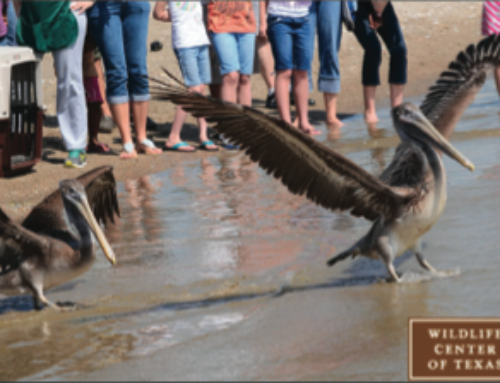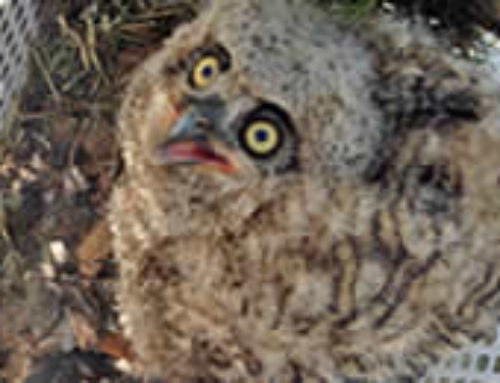
A Pileated and Downy Woodpecker of the same age. The Pileated is Texas' largest woodpecker and the Downy is the smallest.
There are few birds that are any flashier or eye-catching than a Pileated Woodpecker (Dryocopus pileatus) in flight. The Pileated Woodpecker is Texas’ largest woodpecker. The body is similar to that of a crow, but the wingspan is much greater. The coloration is predominately black, with a striking red crested head. The feathers underneath the wing are white as is the face. A black band across the eyes lends a rakish air. The beak is slate black and another band of black runs from the lower beak to the neck. Often there is a red cheek splash.
Woody the Woodpecker is probably the best known example of his species. Many people believe Woody is a Red-headed Woodpecker, but his crest proudly announces he is a Pileated Woodpecker. In areas that are dominated with smaller woodpecker species, Red-headed or Red-bellied Woodpeckers are sometimes mistaken for the larger Pileated. Once spotted, they are impossible to forget or confuse with another bird.

This pair of Pileated Woodpeckers came to the Wildlife Center when their nesting tree was destroyed. They were quite young and while their feathers had formed, many had not yet begun to unfurl from the chitin tube that protects the feather until it is fully formed.
Mating begins in early spring as the male excavates a large nest with multiple entrances to attract a mate. Once mated, the pair will remain year-round protecting their territory. Juveniles and floaters are tolerated during the winter months. Both parents will sit the nest and will even retrieve fallen eggs. The ability to physically retrieve fallen eggs and by extrapolation newly hatched young is rare in birds. The nest will be utilized only once by the Pileated Woodpeckers. These abandoned cavities are a boon to many other species that utilize nest-cavities, but are unable to create them themselves.
Even without seeing a Pileated Woodpecker, you can identify a pair’s territory by looking for square to rectangular holes of the nest cavity or feeding excavations. In addition to hammering to excavate nests or hunt for lunch, the pair (especially the male) will hammer territory challenges to keep interlopers at bay. Their call is a wild crazy laugh.
The Pileated Woodpecker hammers in 1 – 3 second bursts of 15 beats per second. The beak strikes its target at about 21 feet per second and exerts over 1000 times the force of gravity! Talk about a headache! The adaptations necessary to allow all of this pounding are truly astounding! Football players wear sophisticated helmets to protect their brain from the damage of collision, but the woodpecker can pound wood all day and no risk injury. Why?

Several days after intake, they are already looking better and growing FAST. Note that the ends of the tail feathers end in a quill.
Several adaptations protect the bird’s brain from damage. While it appears that the brain lies almost in line with vector of impact, it in fact rests above. The woodpecker’s brain is very small, the surface is smooth, there is relatively little cerebrospinal fluid and it is oriented very tightly in the skull to minimize exposure to deceleration. This prevents the types of concussion that happen when the brain slams against the brain case. The beak itself acts as a shock absorber. In most birds, the lower half of the bill is fixed and a hinge exists between the upper mandible and the frontal bone of the skull. This hinge in the woodpecker is folded inwards so that when a blow is struck the joint undergo tension rather than compression. Compression would allow all of the force to be directly transmitted to the skull. Transmission of force is further minimized by a special muscle that counteracts the tension created in the beak.
People who work with wood often were safety goggles and a mask to protect their eyes from flying debris and their lungs from dust. Woodpeckers have similar safety equipment and they don’t have to remember to dig it out before starting a project. The nictitating membrane (a translucent eyelid that sweeps debris from the eye and keeps it moist, often referred to as the third eyelid) is thicker than other birds and automatically closes just prior to impact. The nasal openings are slits which are covered by special feathers to filter debris and dust.

The Pileated Woodpeckers have been moved to a flight cage and are only a couple of weeks from release
Considering the speed and force the Pileated Woodpecker can exert, it is a marvel that it doesn’t knock itself off of the tree! But nature has again stepped in with interesting adaptations. The tail feathers are much stiffer and end in pointed quills. These special feathers allow the bird to create a stable tripod. The feet are unusual enough they have their own name – zygodactyl. The first toe (hallux) faces backward, while the second and third face forward, the fourth faces backward. This configuration is especially effective in clinging to the side of a tree, so much so that woodpeckers have trouble trying to perch like regular birds.
Pileated Woodpeckers are primarily insectivorous, but do enjoy fruit and berries in season. Their exceptionally long, bristled and sticky tongue makes slurping carpenter ants, beetles and insect larvae out of cracks and crevices a piece of cake.

Once released, the Pileated Woodpeckers will come back for back-up food until they have honed their skills
The pair of Pileated in this article were brought to the Wildlife Center when their nesting tree was destroyed. The pair consists of a male and a female. Sexual dimorphism exists in the species, but it is subtle and consists of differences in adult size and the color of the forehead. Males have a red forehead while that of the female is grey to brownish yellow.
CLICK HERE to view the video of the Pileated Woodpeckers.






Never seen one of these. Thanks for all your great work.